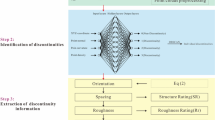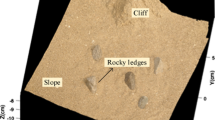Abstract
A quantitative outcrop survey was conducted in three coastal areas in Japan to estimate the relationship between the surface morphology and visual information of well-exposed rocks using photogrammetry of drone flyovers. We generated three-dimensional digital outcrop models in the study areas to produce the hue, saturation, value (HSV) color space images and digital elevation model (DEM) data, together with terrain ruggedness index (TRI) computed from the DEM data. Using the data, we examined whether our machine learning model (MLM) could predict the millimeter-scale surface ruggedness of the given rock outcrop. In the prediction, one of the three studied outcrops was selected for the training data, and various patterns of choices from available georeferenced visual information (i.e., coordinates, H, S, V) and TRI data in the other study areas were used as explanatory variables and response variables, respectively. The MLM with H, S, and V as explanatory variables using the 3σ method for outlier removal showed the smallest Root Mean Square Error of 0.51 × 10−3. The results revealed that our MLM provided reasonable quantitative predictions of surface ruggedness. Additionally, our predictions worked well even in the presence of cast shadows on the studied outcrops, suggesting that the shadow effects were likely negligible. Our findings emphasize that the HSV color space data acquired by drone-flyover photogrammetry alone can quantitatively predict the millimeter-scale surface ruggedness of outcrops, facilitating the acquisition of high-resolution surface morphology data without DEMs.













Similar content being viewed by others
Data availability
The datasets generated and analysed during the current study are available from the corresponding author(s) on reasonable request.
References
Babadagli T, Ren X, Develi K (2015) Effects of fractal surface roughness and lithology on single and multiphase flow in a single fracture: An experimental investigation. Int J Multiph Flow 68:40–58 (2015). https://doi.org/10.1016/j.ijmultiphaseflow.2014.10.004
Baddeley MC, Curtis A, Wood R (2004) An introduction to prior information derived from probabilistic judgements: elicitation of knowledge, cognitive bias and herding. Geol Soc Lond Spec Publ 239:15–27. https://doi.org/10.1144/GSL.SP.2004.239.01.02
Bemis SP, Micklethwaite S, Turner D et al (2014) Ground-based and UAV-Based photogrammetry: a multi-scale, high-resolution mapping tool for structural geology and paleoseismology. J Struct Geol 69:163–178. https://doi.org/10.1016/j.jsg.2014.10.007
Bi S, Yuan C, Liu C et al (2021) A survey of low-cost 3D laser scanning technology. Appl Sci 11:3938. https://doi.org/10.3390/app11093938
Blistan P, Kovanič Ľ, Zelizňaková V, Palková J (2016) Using UAV photogrammetry to document rock outcrops. Acta Montan Slovaca 21:154–161
Buckley SJ, Ringdal K, Naumann N et al (2019) LIME: Software for 3-D visualization, interpretation, and communication of virtual geoscience models. Geosphere 15:222–235. https://doi.org/10.1130/GES02002.1
Byun H, Kim J, Yoon D et al (2021) A deep convolutional neural network for rock fracture image segmentation. Earth Sci Inf 14:1937–1951. https://doi.org/10.1007/s12145-021-00650-1
Carrivick JL, Smith MW, Quincey DJ (2016) Structure from Motion in the Geosciences. https://doi.org/10.1002/9781118895818
Cawood AJ, Bond CE, Howell JA et al (2017) LiDAR, UAV or compass-clinometer? Accuracy, coverage and the effects on structural models. J Struct Geol 98:67–82. https://doi.org/10.1016/j.jsg.2017.04.004
Cucchiara R, Grana C, Piccardi M, Prati A (2003) Detecting moving objects, ghosts, and shadows in video streams. IEEE Trans Pattern Anal Mach Intell 25:1337–1342. https://doi.org/10.1109/TPAMI.2003.1233909
Dostal C, Yamafune K (2018) Photogrammetric texture mapping: a method for increasing the Fidelity of 3D models of cultural heritage materials. J Archaeol Sci Rep 18:430–436. https://doi.org/10.1016/j.jasrep.2018.01.024
Enge HD, Buckley SJ, Rotevatn A, Howell JA (2007) From outcrop to reservoir simulation model: Workflow and procedures. Geosphere 3:469–490. https://doi.org/10.1130/GES00099.1
Géron A (2019) Hands-On Machine Learning with Scikit-Learn, Keras, and TensorFlow, 2nd Edition
Harwin S, Lucieer A (2012) Assessing the Accuracy of Georeferenced Point clouds Produced via Multi-view Stereopsis from Unmanned Aerial vehicle (UAV) Imagery. Remote Sens 4:1573–1599. https://doi.org/10.3390/rs4061573
Hodgetts D (2013) Laser scanning and digital outcrop geology in the petroleum industry: a review. Mar Pet Geol 46:335–354. https://doi.org/10.1016/j.marpetgeo.2013.02.014
James MR, Robson S (2012) Straightforward reconstruction of 3D surfaces and topography with a camera: accuracy and geoscience application. J Geophys Res Earth Surf. https://doi.org/10.1029/2011JF002289. 117:
Katagiri N, Kioka A, Nonoyama M, Hayashi Y (2023) Inhibiting flow-accelerated copper corrosion under liquid jet impingement by utilizing nanobubbles. Surf Interfaces 40:103067. https://doi.org/10.1016/j.surfin.2023.103067
Kingma DP, Ba J (2015) Adam: a method for stochastic optimization. Int Conf Learn Represent 1412:6980. https://doi.org/10.48550/arXiv.1412.6980
Kingsland K (2020) Comparative analysis of digital photogrammetry software for cultural heritage. Digit Appl Archaeol Cult Herit 18:e00157. https://doi.org/10.1016/j.daach.2020.e00157
Kioka A, Strasser M (2022) Oceanic trenches. Treatise Geomorphol 882–900. https://doi.org/10.1016/B978-0-12-818234-5.00167-X
Koterazawa R (1987) Recent Development in Fractography. In: Tetsu-to-Hagane. pp 19–25
Lehmann R (2013) 3σ-Rule for Outlier Detection from the viewpoint of Geodetic Adjustment. J Surv Eng 139:157–165. https://doi.org/10.1061/(ASCE)SU.1943-5428.0000112
Li H, Xu L, Shen H, Zhang L (2016) A general variational framework considering cast shadows for the topographic correction of remote sensing imagery. ISPRS J Photogramm Remote Sens 117:161–171. https://doi.org/10.1016/j.isprsjprs.2016.03.021
Li T, Zhang B, Xiao W et al (2020) UAV-Based photogrammetry and LiDAR for the characterization of ice morphology evolution. IEEE J Sel Top Appl Earth Obs Remote Sens 13:4188–4199. https://doi.org/10.1109/JSTARS.2020.3010069
Liao J, Zhou J, Yang W (2021) Comparing LiDAR and SfM digital surface models for three land cover types. Open Geosci 13:497–504. https://doi.org/10.1515/geo-2020-0257
Lynch SP, Moutsos S (2006) A brief history of fractography. J Fail Anal Prev 6:54–69. https://doi.org/10.1361/154770206X156231
Malik OA, Puasa I, Lai DTC (2022) Segmentation for Multi-rock types on Digital Outcrop photographs using deep learning techniques. Sensors 22:1–17. https://doi.org/10.3390/s22218086
Mandelbrot BB, Passoja DE, Paullay AJ (1984) Fractal character of fracture surfaces of metals. Nature 308:721–722. https://doi.org/10.1038/308721a0
Marques A, Horota RK, de Souza EM et al (2020) Virtual and digital outcrops in the petroleum industry: a systematic review. Earth Sci Rev 208:103260. https://doi.org/10.1016/j.earscirev.2020.103260
Młynarczuk M, Górszczyk A, Ślipek B (2013) The application of pattern recognition in the automatic classification of microscopic rock images. Comput Geosci 60:126–133. https://doi.org/10.1016/j.cageo.2013.07.015
Musleh S, Sarfraz M, Raafat H (2021) Shadow detection of the satellite images of earth using ratio image pixels. Earth Sci Inf 14:377–392. https://doi.org/10.1007/s12145-020-00537-7
Obara B (2007) Identification of transcrystalline microcracks observed in microscope images of a dolomite structure using image analysis methods based on linear structuring element processing. Comput Geosci 33:151–158. https://doi.org/10.1016/j.cageo.2006.07.004
Okin GS (2023) Shadow is related to roughness but MODIS BRDF should not be used to estimate lateral cover. Remote Sens Environ 292:113581. https://doi.org/10.1016/j.rse.2023.113581
Park Y-S, Lek S (2016) Artificial Neural Networks. 123–140. https://doi.org/10.1016/B978-0-444-63623-2.00007-4
Pepe M, Costantino D (2020) Techniques, Tools, Platforms and Algorithms in Close Range Photogrammetry in Building 3D Model and 2D Representation of Objects and Complex Architectures. Comput Aided Des Appl 18:42–65. https://doi.org/10.14733/cadaps.2021.42-65
Pollyea RM, Fairley JP (2011) Estimating surface roughness of terrestrial laser scan data using orthogonal distance regression. Geology 39:623–626. https://doi.org/10.1130/G32078.1
Riley SJ, DeGloria SD, Elliot R (1999) A terrain ruggedness index that Qauntifies Topographic Heterogeneity. Intermt J Sci 5:23–27
Sadeq HA (2019) Accuracy assessment using different UAV image overlaps. J Unmanned Veh Syst 7:175–193. https://doi.org/10.1139/juvs-2018-0014
Salvini R, Vanneschi C, Coggan JS, Mastrorocco G (2020) Evaluation of the Use of UAV Photogrammetry for Rock Discontinuity Roughness characterization. Rock Mech Rock Eng 53:3699–3720. https://doi.org/10.1007/s00603-020-02130-2
Sato T, Yamasaki M, Chiyonobu S (2009) Geology of Akita Prefecture, Japan. Daichi 50:70–83
Sato K, Madokoro H, Nagayoshi T et al (2021) Semantic Segmentation of Outcrop Images using Deep Learning Networks Toward Realization of Carbon Capture and Storage. In: 2021 The 21st International Conference on Control, Automation and Systems (ICCAS 2021). p 11p
Sharma R, Kim M, Gupta A (2022) Motor imagery classification in brain-machine interface with machine learning algorithms: classical approach to multi-layer perceptron model. Biomed Signal Process Control 71:103101. https://doi.org/10.1016/j.bspc.2021.103101
Singh A, Gaurav K, Rai AK, Beg Z (2021) Machine learning to estimate surface roughness from satellite images. Remote Sens 13:1–27. https://doi.org/10.3390/rs13193794
Smith AR (1978) Color gamut transform pairs. ACM SIGGRAPH Comput Graph 12:12–19. https://doi.org/10.1145/965139.807361
Smith MW, Carrivick JL, Quincey DJ (2015) Structure from motion photogrammetry in physical geography. Prog Phys Geograph 40:247–275. https://doi.org/10.1177/0309133315615805
Sonawane JS, Patil DR (2014) Prediction of heart disease using multilayer perceptron neural network. Int Conf Inf Commun Embed Syst 4:1–6. https://doi.org/10.1109/ICICES.2014.7033860
Spokas K, Peters CA, Pyrak-Nolte L (2018) Influence of Rock Mineralogy on reactive fracture evolution in Carbonate-Rich Caprocks. Environ Sci Technol 52:10144–10152. https://doi.org/10.1021/acs.est.8b01021
Sural S, Gang Qian, Pramanik S (2002) Segmentation and histogram generation using the HSV color space for image retrieval. Proceedings Int Conf Image Process 2:II-589-II–592. https://doi.org/10.1109/ICIP.2002.1040019
Tziavou O, Pytharouli S, Souter J (2018) Unmanned aerial vehicle (UAV) based mapping in engineering geological surveys: considerations for optimum results. Eng Geol 232:12–21. https://doi.org/10.1016/j.enggeo.2017.11.004
Villarreal CA, Garzón CG, Mora JP, Rojas JD, Ríos CA (2022) Workflow for capturing information and characterizing difficult-to-access geological outcrops using unmanned aerial vehicle-based digital photogrammetric data. J Ind Inf Integr 26:100292. https://doi.org/10.1016/j.jii.2021.100292
Wang C, Jiang L, Bobet A, Yoon H, Pyrak-Nolte LJ (2024) Fabric controls on fracture surface roughness of an architected rock material. Mech Res Commun 135:104223. https://doi.org/10.1016/j.mechrescom.2023.104223
Yamada Y, Masui R, Tsuji T (2013) Characteristics of a tsunamigenic megasplay fault in the Nankai Trough. Geophys Res Lett 40:4594–4598. https://doi.org/10.1002/grl.50888
Zaki NHM, Chong WS, Muslim AM, Reba MNM, Hossain MS (2022) Assessing optimal UAV-data pre-processing workflows for quality Ortho-image generation to support coral reef mapping. Geocarto Int 37:10556–10580. https://doi.org/10.1080/10106049.2022.2037732
Zhang H, Qu S, Li H et al (2020) A moving Shadow Elimination Method based on Fusion of Multi-feature. IEEE Access 8:63971–63982. https://doi.org/10.1109/ACCESS.2020.2984680
Acknowledgements
We thank Y. Okuma for fruitful discussions on geological interpretations. The manuscript benefited from constructive reviews by two anonymous reviewers. The computation was partly performed on the ITO supercomputer system (General Projects to A.K.) at the Research Institute for Information Technology of Kyushu University. This work was supported by Fukada Field Survey Grants of Fukada Geological Institute (to T.N.), Education and Research Program for Mathematical and Data Science from Kyushu University (to A.K.), Maeda Engineering Foundation Grant (to A.K.), and JSPS Bilateral Joint Research Project JPJSBP120214811 (to A.K.).
Funding
This work was supported by Fukada Field Survey Grants of Fukada Geological Institute (to T.N.), Education and Research Program for Mathematical and Data Science from Kyushu University (to A.K.), Maeda Engineering Foundation Grant (to A.K.), and JSPS Bilateral Joint Research Project JPJSBP120214811 (to A.K.).
Author information
Authors and Affiliations
Contributions
Takumu Nakamura: Conceptualization; Data curation; Formal analysis; Funding acquisition; Investigation; Methodology; Software; Validation; Visualization; Writing - original draft; Writing - review & editing. Arata Kioka: Conceptualization; Funding acquisition; Investigation; Methodology; Project administration; Resources; Software; Supervision; Writing - original draft; Writing - review & editing. Kosuke Egawa: Supervision; Writing - review & editing. Takuma Ishii: Investigation; Writing - review & editing. Yasuhiro Yamada: Conceptualization; Supervision; Writing - review & editing.
Corresponding authors
Ethics declarations
Competing interests
The authors have no competing interests to declare that are relevant to the content of this article.
Additional information
Communicated by H. Babaie.
Publisher’s Note
Springer Nature remains neutral with regard to jurisdictional claims in published maps and institutional affiliations.
Rights and permissions
Springer Nature or its licensor (e.g. a society or other partner) holds exclusive rights to this article under a publishing agreement with the author(s) or other rightsholder(s); author self-archiving of the accepted manuscript version of this article is solely governed by the terms of such publishing agreement and applicable law.
About this article
Cite this article
Nakamura, T., Kioka, A., Egawa, K. et al. Estimating millimeter-scale surface roughness of rock outcrops using drone-flyover structure-from-motion (SfM) photogrammetry by applying machine learning model. Earth Sci Inform (2024). https://doi.org/10.1007/s12145-024-01280-z
Received:
Accepted:
Published:
DOI: https://doi.org/10.1007/s12145-024-01280-z




